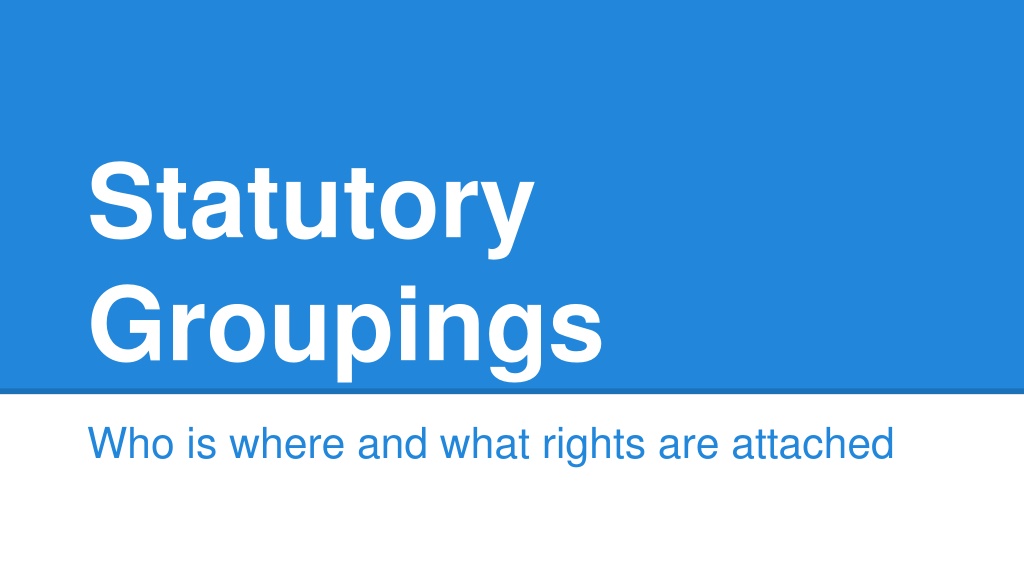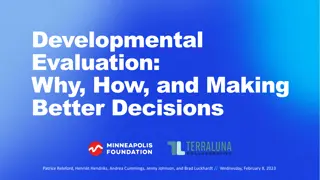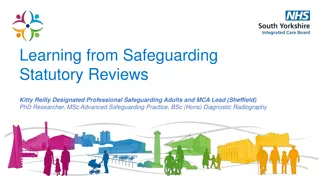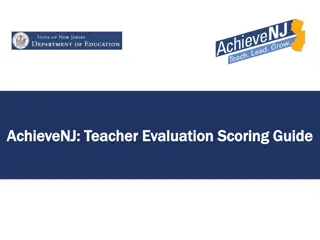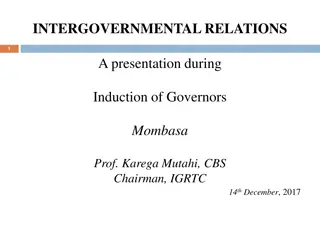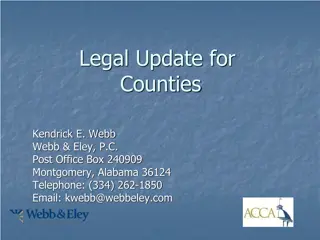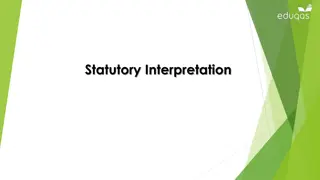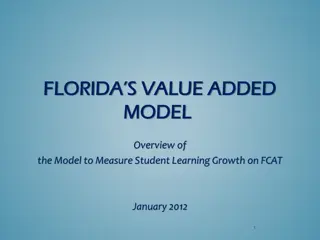Understanding Statutory Groupings in Teacher Evaluation Systems
Explore the statutory groupings in teacher evaluation systems, including the relationship between TAP and ISBE ratings, factors determining grouping in Group I to Group IV, and the specific rights attached to each group based on summative ratings. Learn who falls into Group 1 and Group 2 based on performance evaluation ratings and contractual terms. Discover the importance of the TAP Wheel in understanding the correlation between TAP and ISBE ratings.
Download Presentation

Please find below an Image/Link to download the presentation.
The content on the website is provided AS IS for your information and personal use only. It may not be sold, licensed, or shared on other websites without obtaining consent from the author. Download presentation by click this link. If you encounter any issues during the download, it is possible that the publisher has removed the file from their server.
E N D
Presentation Transcript
Statutory Groupings Who is where and what rights are attached
ETA/U46 Teacher Appraisal Plan (TAP) Key background information During the Summative Conference both a TAP rating and an ISBE rating are determined.
ETA/U46 Teacher Appraisal Plan (TAP) Key background information The professional practice component of the TAP is based upon the work of Charlotte Danielson. Unsatisfactory Basic Proficient Distinguished The four summative TAP ratings available are:
ETA/U46 Teacher Appraisal Plan (TAP) Key background information During the summative conference both a TAP rating and an ISBE rating are determined. Unsatisfactory Needs Improvement Proficient Excellent The available ISBE ratings, by Illinois School Code, are:
Relationship between TAP and ISBE Key background information It s important to note that the correspondence between the TAP and ISBE ratings are not one to one and is modeled and explained through the TAP Wheel . That explanation can be found on the Transfer Reassignment Tools page of the ETA website.
Statutory Groupings School code requires that teachers are grouped annually based upon their summative rating(s). Group I Group II Group III Group IV There are very specific factors that determine the member s grouping. Each group has a specific set of rights as they pertain to recall.
Who is in Group 1? Grouping 1 shall consist of each teacher who is not in contractual continued service and who 1) has not received a performance evaluation rating, 2) is employed for one school term or less to replace a teacher on leave, or 3) is employed on a part-time basis. Group IV Group III Group II Group I None ISBE Summative Rating in System
Who is in Group 2? Group IV Group III Grouping 2 shall consist of each teacher with a Needs Improvement or Unsatisfactory performance evaluation rating on either of the teacher's last 2 performance evaluation ratings. Group II Group I Any or None Any or None ISBE Summative Rating in System NI Any NI U Any U
Who is in Group 3? Grouping 3 shall consist of each teacher with a performance evaluation rating of at least Satisfactory or Proficient on both of the teacher's last 2 performance evaluation ratings, if 2 ratings are available, or on the teacher's last performance evaluation rating, if only one rating is available, unless the teacher qualifies for placement into grouping 4. Group IV Group III Group II Group I ISBE Summative Rating in System P E P E E U E P E E E NI
Who is in Group 4? Grouping 4 shall consist of each teacher whose last 2 performance evaluation ratings are Excellent and each teacher with 2 Excellent performance evaluation ratings out of the teacher's last 3 performance evaluation ratings with a third rating of Satisfactory or Proficient. Group IV Group III Group II Group I ISBE Summative Rating in E E E E E P E P E E E E P E System
Reduction in force - dismissal order Among teachers qualified to hold a position, teachers must be dismissed in the order of their groupings, with teachers in grouping one dismissed first and teachers in grouping 4 dismissed last. Statutory Grouping Listing Order Group IV RIF Order of Dismissal Group III Group II Group I
Within grouping sorting rules Group IV Group III Group II Within grouping one, the sequence of dismissal must be at the discretion of the school district or joint agreement. Group I
Within grouping sorting rules Within grouping 2, the sequence of dismissal must be based upon average performance evaluation ratings, with the teacher or teachers with the lowest average performance evaluation rating dismissed first. A teacher's average performance evaluation rating must be calculated using the average of the teacher's last 2 performance evaluation ratings, if 2 ratings are available, or the teacher's last performance evaluation rating, if only one rating is available, using the following numerical values: 4 for Excellent; 3 for Proficient or Satisfactory; 2 for Needs Improvement; and 1 for Unsatisfactory. Group IV Group III Group II Group I
Within grouping sorting rules As between or among teachers in grouping 2 with the same average performance evaluation rating and within each of groupings 3 and 4, the teacher or teachers with the shorter length of continuing service with the school district. Group IV Group III Group II Group I
Within grouping sorting rules As between or among teachers in grouping 2 with the same average performance evaluation rating and within each of groupings 3 and 4, the teacher or teachers with the shorter length of continuing service with the school district. Group IV Group III Group II Group I
Technical details within From the Illinois School Code (105 ILCS 5/24-12) For purposes of this subsection (b), subject to agreement on an alternative definition reached by the joint committee described in subsection (c) of this Section, a teacher's performance evaluation rating means the overall performance evaluation rating resulting from an annual or biennial performance evaluation conducted pursuant to Article 24A of this Code by the school district or joint agreement determining the sequence of dismissal, not including any performance evaluation conducted during or at the end of a remediation period. For performance evaluation ratings determined prior to September 1, 2012, any school district or joint agreement with a performance evaluation rating system that does not use either of the rating category systems specified in subsection (d) of Section 24A-5 of this Code for all teachers must establish a basis for assigning each teacher a rating that complies with subsection (d) of Section 24A-5 of this Code for all of the performance evaluation ratings that are to be used to determine the sequence of dismissal. A teacher's grouping and ranking on a sequence of honorable dismissal shall be deemed a part of the teacher's performance evaluation, and that information may be disclosed to the exclusive bargaining representative as part of a sequence of honorable dismissal list, notwithstanding any laws prohibiting disclosure of such information. A performance evaluation rating may be used to determine the sequence of dismissal, notwithstanding the pendency of any grievance resolution or arbitration procedures relating to the performance evaluation. If a teacher has received at least one performance evaluation rating conducted by the school district or joint agreement determining the sequence of dismissal anda subsequent performance evaluation is not conducted in any school year in which such evaluation is required to be conducted under Section 24A-5 of this Code, the teacher's performance evaluation rating for that school year for purposes of determining the sequence of dismissal is deemed Proficient. If a performance evaluation rating is nullified as the result of an arbitration, administrative agency, or court determination, then the school district or joint agreement is deemed to have conducted a performance evaluation for that school year, but the performance evaluation rating may not be used in determining the sequence of dismissal. While a Proficient of Excellent rating is required to successfully complete a Remediation plan, that rating is precluded from consideration in the generation of the the Grouping. Even if a member has an ongoing appeal of a summative rating, informally or through any available grievance process, the district may use the rating in the creation of the Grouping list. This is the language that creates the default Proficient rating for members.
Recall Rights If the board or joint agreement has any vacancies for the following school term or within one calendar year from the beginning of the following school term, the positions thereby becoming available must be tendered to the teachers so removed or dismissed who were in groupings 3 or 4 of the sequence of dismissal and are qualified to hold the positions, based upon legal qualifications and any other qualifications established in a district or joint agreement job description, on or before the May 10 prior to the date of the positions becoming available, provided that if the number of honorable dismissal notices based on economic necessity exceeds 15% of the number of full-time equivalent positions filled by certified employees (excluding principals and administrative personnel) during the preceding school year, then the recall period is for the following school term or within 2 calendar years from the beginning of the following school term. Among teachers eligible for recall pursuant to the preceding sentence, the order of recall must be in inverse order of dismissal, unless an alternative order of recall is established in a collective bargaining agreement or contract between the board and a professional faculty members' organization. All members in grouping 3 or 4 who were subject to RIF have recall rights. The Elgin Agreement does not provide for an alternative order of recall, therefore the list will not be updated prior to recall.
Grouping - quick overview Grouping Who can be in this group? Sort within the group Recall Rights if RIFd Yes - All and in reverse order of dismissal IV All members with at least 2 summative ratings Seniority Available to any with at least 2 summative ratings; also represents the highest placement possible for those with only 1 summative rating Yes - All and in reverse order of dismissal III Seniority Limited - Only for those with a single summative rating, with a rating of Needs Improvement (NI); for those with two summative ratings to consider, only one rating of NI with the other being Proficient or Excellent. Predominantly tenured teachers since most, if not all, pre-tenured who qualify are non-renewed Average of prior 2; seniority II Open only to 1st year teachers without any summative rating I District determined None; but eligible for rehire
Honorable Dismissal - recommend to non-renew Nothing in this subsection (b) shall be construed as limiting the right of a school board or governing board of a joint agreement to dismiss a teacher not in contractual continued service in accordance with Section 24-11 of this Code. This means that pre-tenured teachers in good standing (Proficient or Excellent summative ratings) can be non-renewed (dismissed) without recall rights It should be noted that these individuals do NOT have recall rights but they may be rehired - this also applies to members in Group 1 that receive a RIF notice
